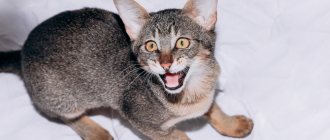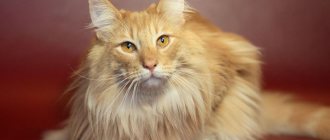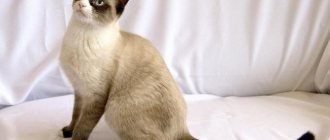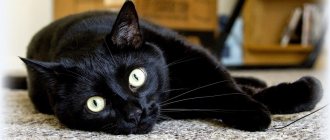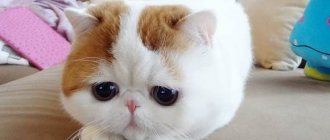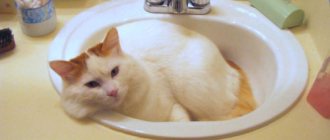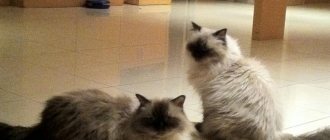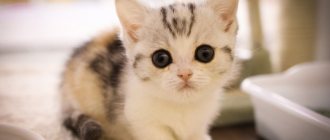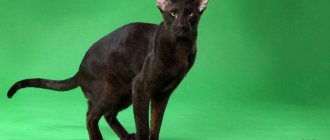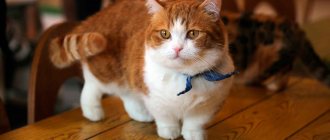The spotted cat is a breed whose roots go back to the world of wild animals. The pattern in the form of spots was inherited by modern spotted pets from ancestors living in natural conditions and forced to camouflage. Spotted cats, in addition to their appearance, inherited character traits from their ancestors: fearlessness, independence, mobility. Such animals do not require special care and attention from the owner, so they can be owned by those who are often absent from home.
It must be said that many of the modern spotted cat breeds are bred artificially. This may affect their health: stomach weakness and some genetic diseases are possible.
The most popular breeds of spotted cats are the Bengal, Scottish Fold, Californian Radiant, Ocicat, and Australian Smoky.
Bengal cat
The breed was obtained by crossing an outbred cat with a wild leopard. The breed was bred by geneticist D. Mill. The color scheme of Bengal cats' fur coats is very variable, because animals of different appearances were involved in the breeding of the breed. Typically, the Bengal's fur has a gray or brown tint, and the top of the coat is decorated with dark oblong spots.
The ears of a Bengal cat are oblong in shape. The eyes are almond-shaped and large. The neck is quite long, the body is elongated. The tail is medium, rounded at the end. The coat is short.
Spotted Bengal cats are graceful, sociable, and intelligent. Many are trainable. Despite their wild roots and penchant for hunting and swimming, they do not show aggression. But they may well bring prey for the owner, laying it at his feet.
Description
Tabby cats become the favorites of many due to their spectacular color.
Fur with brightly highlighted stripes attracts the attention of others and becomes the main distinguishing feature of the pet. There are several variants of striped color, each with its own special characteristics.
Let's take a closer look at them.
Classic (or traditional)
This type of tabby color in domestic cats is characterized by the presence of narrow stripes that are located along the pet’s spine
It is important to note that usually the stripe in the center is a darker shade, while the stripes on the sides are noticeably lighter. In addition, such animals have a pattern on the sides of the body.
Mackerel
A distinctive characteristic of this tabby color is uninterrupted stripes. In addition, they themselves are quite narrow and may have a slight smooth bend. It is not uncommon to see small but distinct markings on the paws and tails of mackerel-colored striped animals. Another characteristic of pets is the presence of dark stripes that run from the outer corners of the eyes to the cheeks.
Striped color with spots
This option is the brightest and most colorful among all existing ones. The variety got its name due to the fact that the stripes that run along the cat’s body are constantly interrupted. In this regard, it may seem that these are not stripes at all, but ordinary spots.
At the same time, despite some differences between individual varieties, tabby cats have certain common features that distinguish them from all other furry pets. These signs usually include:
- a spot in the shape of the letter “M” located on the forehead of a pet (the outline of the pattern, as well as its color and size may vary);
- two types of hair that make up the wool (one of them is the background, and the other is used to draw the immediate pattern);
- there is a pattern in the form of rings on the chest (this pattern may resemble necklaces).
The thing is that a special gene is responsible for such coat coloring, which can manifest itself in any animal. In addition, scientists have discovered a rather interesting fact: the gene responsible for striping also ensures a good and stable immune system.
Another important sign is that tabby cats are endowed with fairly developed intelligence and have pronounced mental abilities. This fact will be useful in the process of training a cat (for example, when you train your pet to use the litter box).
In addition, veterinarians and scientists note that tabby cats are quite active animals that (among other things) have a fairly developed hunting instinct. This is why your pets can bring you rats, mice and other animals they have caught.
Easy and quick adaptation to new environmental conditions, as well as the ability to navigate well in unfamiliar terrain, also distinguish tabby cats from other cats. But it is also noted that animals live quite a long time.
As for the character and behavior of cats, striped pets are distinguished by a rather calm, docile and balanced disposition. They are resistant to various external stresses and withstand unfavorable influences from the outside.
Interesting fact. In nature, no two tabby cats are exactly alike. All pets have a unique color and pattern, unlike any other. Thus, the coloring of tabby cats (like human fingerprints) is an individual characteristic, thanks to which one can distinguish one animal from another.
Scottish fold cat
The Scots Fold can be of any color, including spotted, harlequin, and brindle. The spots are united on the back into one long dark stripe stretching along the body.
The Scottish Fold cat has an unusual ear structure - they are curved down and forward. Kittens are born with straight ears, and by the age of one month their ears take on their specific configuration. If the ears remain straight, then the animals belong to the Scottish Straight breed.
The Scottish breed of cats, including spotted ones, are distinguished by the round shape of their head, muzzle, and eyes. The nose is wide and short. The body is covered with dense, soft, short hair, which can have different color options.
Skunk.
Skunks live in North America in small families or alone. Cute animals have an unusual black and white color. Representatives of the animal world that have light stripes on their backs have a unique ability.
Glands located under the tail secrete fluid in defense against predators. The smell is so pungent that it repels any enemy.
British cat
British wool can be either plain or have different patterns. There are three types of patterns on the fur coat of these animals:
- Tabby;
- Spotted;
- Marble.
British cats become attached to their owners, but behave reservedly around strangers. They are very hard to touch, and it will take a lot of time to earn their trust and get in touch with them.
The British are mannered, aristocratic, and proud. Behind her sweet appearance and chubby cheeks lies a complex inner world.
Number of species
Currently, according to scientists, the number of this species does not exceed 10 thousand individuals and is steadily declining. This is due to deforestation and destruction of natural perennial habitat, as well as a reduction in food supply and uncontrolled poaching. In some Indian states, the meat of this rare animal is eaten.
The number of rusty cats is steadily decreasing
The species is considered vulnerable and is on the verge of extinction. Rusty cats are protected and protected by the international community; since 2002 they are listed in the International Red Book and in the CITES Convention (Appendix II) as endangered animals. Hunting them is strictly prohibited.
California shining cat
This spotted cat is a breed created in 1976 in California. 5 years earlier, screenwriter Paul Casey traveled to Tanzania, where he learned about large-scale poaching of leopards. He set out to create a breed of domestic cats that looked like a leopard. His goal was to eradicate the desire among people to use the skin of these animals for clothing, because the fur of a leopard is so similar to the fur coat of a pet.
The California shining cat really resembles a leopard, not only in color, but also in many other characteristics. For example, their demeanor, grace and muscularity of the body were inherited from their wild ancestors.
Representatives of this breed tend to bend their paws at right angles, as if the animal is preparing to jump. This finally reveals the predatory roots of the California radiant.
The spots on the body of representatives of this breed can be of various shapes - triangle, oval, square, circle.
How to choose a spotted kitten
First, decide what kind of animal you want to get: a wild predator or a domestic cat - spotted color and exotic appearance are quite possible in both of these options. But in the first case, very large costs will be required, and not only financial: to tame a wild kitten, it will take a huge amount of time, effort, attention and patience - without a guaranteed positive result. It is quite possible that the predator will remain a predator, and its natural aggression will manifest itself at the most unexpected moment.
Yes, some cat species are more prone to domestication than others. These include, for example, the following animals:
- ocelot;
- serval;
- oncilla;
- Geoffroy's cat.
However, species identity is not an absolute guarantee that the animal will be tame. In some individuals, both animal instincts and natural distrust of humans are too strong. And then all your efforts may be in vain - you will have to get rid of the source of danger in your home. But the wild cat is not to blame for anything: he did not ask to come into your home, his place is in nature or, in extreme cases, in a zoo, where specialists will work with him.
There are very cute-looking cats that you shouldn’t even try to tame. The charming Pallas cat will remain a wayward aggressor, and the spotted baby black-footed cat will never conquer her predator instinct. And, of course, do not try to experiment with taming big wild cats: leopards, leopards and jaguars. All attempts to place them in a human apartment ended tragically - sooner or later the tiny kitten grew into a wild beast and it was no longer possible to control it...
A leopard kitten will never be completely tame.
If it’s just a question of a prestigious spotted color, opt for some safe option, specially bred for keeping in an apartment. There are many interesting domestic breeds with exotic speckled coats - they have the appearance of a wild animal and a completely docile, predictable character. But such cats are quite rare and expensive - when buying them you need to be careful not to fall into the web of scammers.
When preparing for such a purchase, carefully study the standard and features of the breed you like. If possible, involve an experienced felinologist in your selection and, together with him, examine your future baby, his parents and littermates. And, of course, do not buy a kitten from dubious sellers - only from reputable nurseries and only under an agreement with the breeder.
The spotted British kitten is a rare occurrence in a familiar breed.
Spotted kittens of domestic breeds differ from all others only in their unusual color. This version of the tabby is available in many common breeds, and a cute spotted baby can be purchased quite inexpensively. At the same time, you will have a guarantee that your pet will not have problems with education and behavior. If you want to be guaranteed to get a show-class animal, follow the same recommendations as when buying a kitten of a rare exotic breed.
Buying a kitten that is too small is always a very big risk
And one more important point. Experienced zoopsychologists advise purchasing wild cat cubs only at a very young, suckling age: a month - maximum one and a half months. Only then can the animal, through the so-called imprinting, perceive the person as its parent and accept your family as its own. In this case, there will be a chance to tame the little savage.
But this measure is forced, and the risks are very high. A kitten that is separated from its mother in such different ways can easily get sick and even die; It is very difficult to feed him correctly. If you decide to have a pet of one of the domestic breeds, then there will be no need to take risks. However, a responsible breeder will not sell you a kitten before 13 weeks of age, when it has already been vaccinated and quarantined, and its feeding schedule has been fully established.
Australian smoky cat
The homeland of this cat is Australia. The breed appeared as a result of selection of Abyssinian and Burmese breeds. The cat is called smoky because its fur has a characteristic shade. The colors of the fur coat can be different - from bluish to peach. The spots are distinguished by ticking.
This cat's eyes can be different shades of green. The ears are wide, straight, slightly rounded at the ends. The cat itself is medium in size.
The Australian Smoky has a calm temperament, friendliness, and sociability. She does not tend to show her claws, so even small children can play with her. By the way, this cat loves babies very much. In relations with other animals living in the house, he also shows tolerance.
N
Napoleon
These cats make great pets as they are very sweet and loving, and they get along well with children and other pets. They really don't like to be left alone, so they are best suited for families who will have a lot of time to devote to their pet.
German Rex
German Rex cats are energetic and friendly, and they get along well with anyone, from small children to the elderly. They are quite playful and love activity, so give them plenty of space to run and play.
Nibelung
The best thing about the Nibelungs is their personality. Loving and sweet, they form close bonds of love and trust with their owners and remain extremely loyal and loyal throughout their lives.
Norwegian forest
She has long, beautiful fur, fluffy ears and a shaggy tail. This is a gentle, friendly cat who loves to be around people. The Norwegian Forest is a slow maturing breed, reaching full size at approximately five years of age.
Neva Masquerade
There is a bit of controversy and confusion surrounding the Neva Masquerade. Some consider it as a color variation within the Siberian breed, and others recognize the Neva Masquerade and Siberian as two separate breeds, however some enthusiasts consider it a threat to the purity of the Siberian breed.
Ocicat
This breed does not have savages in its pedigree. Her ancestors are Siamese and Abyssinians, which were later crossed with American Shorthairs. The birthplace of the breed is the USA.
Externally, the animal resembles a wild ocelot, which is why the breed was given the name “Ocicat”.
The animal's fur is dotted with spots located on a plain base. The main background of the coat can be different - from blue to brown. The fur is short.
The Ocicat's head is medium in size, its muzzle is oblong. The ears are round and large. The eyes are expressive, almond-shaped. Their color can be any except blue.
By nature, Ocicats are extroverts. They are active, sociable, and love to have fun. They are able to find a common language with all family members, but they choose only one owner.
Possible tabby colors
Among tabby cats, gray and silver cats predominate with markings of a wide variety of colors: lilac, chocolate, blue, smoky black, reddish. But this does not mean that other tabby colors are rare. In the table below we look at the main variations of tabby color.
Table 2. Possible flower combinations for tabby color
| Color name | Marking color | Leading coat shade |
| Amber | Smoke black | Peach |
| Black silver | Deep black | Silver |
| Blue | Gray dust | Ivory |
| Blue silver | Grey | White |
| Bronze | Dark chocolate | Warm cream |
| Brown | Black night | Gray with brown or copper fade |
| Cameo | Fiery red | Warm ivory |
| Caramel | Milk chocolate with light color | Beige |
| Coal | Black chocolate | Smoke gray |
| Chestnut | Bright brown | Cream with possible orange undertone |
| Chocolate silver | Milk chocolate | Light blue silver |
| Cinnamon | Light chocolate with red flecks | Several shades lighter than the drawing |
| Golden cinnamon | Cinnamon | Ivory |
| Cream | Bright cream | Pale cream |
| Cream silver | Cream | Delicate silver |
| Faun | Light beige with cinnamon | Pale beige |
| Gold | Black | Milk chocolate with light color |
| Delicate amber | Grey, light gray | Tender peach |
| Lilac | Gray with splashes of pink or blue | Light cream |
| Peach | Brown with pink | Delicate cream |
| Red | Fire orange | Several tones softer than the original pattern |
| Purple silver | Lilac | Light silver with lilac splashes |
| Silver | Deep black | White |
It is worth noting that colors may vary depending on the design. Thus, spotted patterns are often presented in warm colors: golden, chocolate, wheat, brown, reddish, red. The classic type combines contrasting patterns of dark stripes on a light background: cream, yellowish, gray. The basis for dark striped patterns is silver and gray. The ticked type offers almost all possible colors. You can read about the mechanisms of genetic inheritance of pigments from cat to cat below.
Pigments and options for their transmission
In addition, the pattern may vary depending on the breed.
Table 3. Tabby color options for different breeds
| Breed | Color name | Marking color | Primary coat color |
California speckled | Bronze, coal, snow leopard, royal glitter | Bronze - chocolate, charcoal - dark chocolate, snow leopard - black, glitter - brown with black | Bronze, snow leopard - ivory, coal - dark gray, glitter - gold |
Egyptian Mau | Mottled Bronze, Smoke Spots, Mottled Tin | Bronze – chocolate, haze – dark chocolate, tin – gray-black | Bronze - cream, haze - dark gray, tin - silver |
Ocicat | Golden cinnamon, sienna, spotted tawny | Cinnamon – chocolate, sienna – beige, tawny – dark chocolate | Cinnamon, sienna - ivory, tawny - red |
| Australian smoke | Golden haze, peach | Haze - golden chestnut, peach - brown with a hint of pink | Haze is several shades lighter, peach is a light cream |
Bengal cat | Leopard, snow | Leopard - red markings in black circles, snow - cream markings in black circles | Leopard – yellow cream, snow – white |
Tabby cats with a rarer color are valued higher - because of this, they can cost more than their counterparts.
Toyger
The Toyger is a breed for those who would not mind having a tiger in their home. Representatives of this breed really resemble wild tigers, but in a mini version. They have a muscular body, brindle color, and short dense hair. However, their disposition is not at all predatory: they are very affectionate and friendly, like diligent pets. Translated, “toyger” means “toy tiger.”
Toygers are smart and highly trainable, and can be trained. They are sociable and playful and love to have fun. Find a common language with most people and animals.
They choose a master for themselves, to whom they are endlessly devoted. At the same time, the toyger is unpretentious and does not require increased attention to itself. Therefore, this breed is perfect for those who often leave the house.
History of wool patterns
In the wild, the most common method of camouflage among animals is dark spots on the fur - they imitate the play of light and shadow, as if crushing the animal’s body, thus helping it to mimic the environment. The spotted color is most widespread in many species of predatory cats - both large and small, living on different continents of the planet.
The spotted color is very popular among wild cats.
Even among uniformly colored lions and pumas, the cubs are born spotted and remain in this camouflage “clothing” until they grow up and are able to defend themselves on their own.
Red cougar kittens wear spotted coats
The history of spotted patterns begins in ancient times, with the appearance of the first predatory mammals. Then nature experimented a lot with colors, and this option became one of the most successful. According to scientists, mahairods, smilodon, xenosmilus, giant jaguars and cheetahs, as well as many other prehistoric cat monsters, were spotted.
The terrible Smilodon (saber-toothed tiger) is depicted as spotted
Modern wild cats, fortunately, have become more modest in size than their distant ancestors, but the successful “polka dot” color has remained very popular among a large number of species. Leopard print is a type of tabby cat color that is very common in the wild and much less common in pets. Of the four dozen species of the cat family, two thirds have spotted coats.
Video: the saber-toothed tiger was not striped, but spotted
Serengeti
There are only a few hundred representatives of the Serengeti breed on the entire planet. Their homeland is America. The breed was developed not so long ago - in the 1990s. To create the Serengeti cats, matings were carried out between a Bengal cat and an Oriental shorthaired spotted cat.
Visually, the Serengeti is similar to the predatory servals, although they are not related. Its wild appearance combined with a non-aggressive character makes this cat surprisingly attractive.
The Serengeti has a medium-sized body that is athletic and athletic. Males are much larger than females. The tail is wide, its tip is black. The eyes of the Serengeti are large, widely spaced, and honey-colored.
Savannah is half Serval
This large (up to 60 cm at the withers) spotted hybrid cat, originally from America, tops the list of the most expensive pets. Serval and Bengal blood flows in her veins. They are incredibly loyal, intelligent, energetic animals with phenomenal memories, which allows them to learn quickly.
Savannah
The most optimal conditions for keeping these large spotted cats is a special enclosure in a private house. Savannahs have a pronounced hunting instinct; they sometimes hone their skills on their owners. It is recommended to wean a kitten from this harmful and sometimes dangerous habit as early as possible with the help of regular outdoor games and toy mice.
Sokoke
The ancestors of this cat are the forest cats of Kenya. Sokoke is a natural breed that has not been touched by human hands.
Despite its wild ancestors, the Sokoke cat is of medium size (weight - 3-5 kg). The head is wedge-shaped and elongated.
The ears are medium, wide at the base, and may have tufts. The eyes are slightly inclined to the base of the ears, surrounded by a dark rim. Eye color can be green, amber, yellow.
The Sokoke's coat is short, with little or no undercoat. It feels harsh to the touch.
Representatives of this breed are very playful, even hyperactive. They love children and show tolerance towards them. Sokoke are quite independent, but they will have a hard time being separated from their owner for a long time.
Features of color
Most breeds of spotted cats are artificially bred. Nevertheless, the genes of such cats contain an admixture of wild animals, which applies not only to fur. It is worth considering why animals need such coloring in general. The thing is that spotted fur helps wild cats camouflage in the wild. This allows her to sneak up on prey unnoticed or hide from an enemy.
Wild felines are first-class hunters. Of course, domestic cats lack the desire to search and catch prey. However, spotted cats are very unpretentious and graceful creatures. They adopted this from their wild brothers. Such animals are extremely independent.
This is especially true for those owners who want to have a pet, but may often be away from home or do not have time for frequent games with the cat and for careful care of it.
It is important to note that some pets may have problems with the stomach or cardiac system. Unfortunately, such problems are not so uncommon for breeds that were bred artificially.
Photo
Is there a street breed?
The division based on appearance happened much later:
- The history of breeds begins in 1000. The first mentions of cats date back to around this time. She is also considered the ancestor of the Siberian longhaired population.
- Later, Siamese, Abyssinians, Egyptian Mau, Persians and Turkish Angora were identified. Even the names clearly show the region from which they all migrated to Europe.
- 1758 Swedish naturalist Carl Linnaeus introduced the concept of Felis catus, a binomial name for the species.
- 17 years later (1775), his colleague from Germany von Schreber supplemented this section with the name Felis silvestris, identifying wild cats as a separate group.
- 1871 The first official cat show took place in London - 170 animals were shown in 25 categories.
From that moment on, the cat world was divided into purebred purebreds and simple street cats.
No one would dare to claim that outbred cats have any characteristic features. The point is not only in their diversity, but also in their amazing adaptability. Even formerly pampered pets quickly adapt to the street.
They have offspring with any homeless partner and thereby replenish the population of outbred animals.
What to look for when choosing a kitten
Ashera is the most expensive cat. Even a fifth-generation mixed breed costs much more than a purebred (for example, British) kitten with a pedigree. The high cost is associated not only with the exclusivity of the breed, but also with the peculiarities of breeding. Today, you will have to pay at least one and a half million for a pet, fortunately, in rubles. However, every year the price of kittens only increases.
Before buying a pet, you should make sure of its physical and mental health. Active, playful and social, Asher kittens should not show displeasure when interacting with their future owner. Also, babies should not be too thin or overfed. A rounded tummy, in which you can easily feel the ribs, is an indicator of the cat’s normal nutrition.
You should inspect the living conditions in the nursery. Cats of this breed need a lot of space to live and play, large toys and scratching posts. Often a tree is placed for pets, along which they happily climb to the ceiling.
You should buy an animal only after installing a chip and receiving a veterinary passport with all the necessary vaccinations.
Breeders often require early booking as a condition of purchase. Long before the cat gives birth, you can make an advance payment for your future pet, and then wait several months until it is born and gets stronger. Only after this you can choose a kitten for yourself. Another sign of a quality breeder is the sale of a cat at the age of 12 months after castration. Sterilization is necessary to prevent wild genes from waking up.
Ashera is rightfully considered one of the best cat breeds. A graceful, intelligent and delicate cat will be an ideal companion for walks, active games, and relaxation. The beauty and perfection of a pet will not leave anyone around you indifferent and will make a lasting impression.
